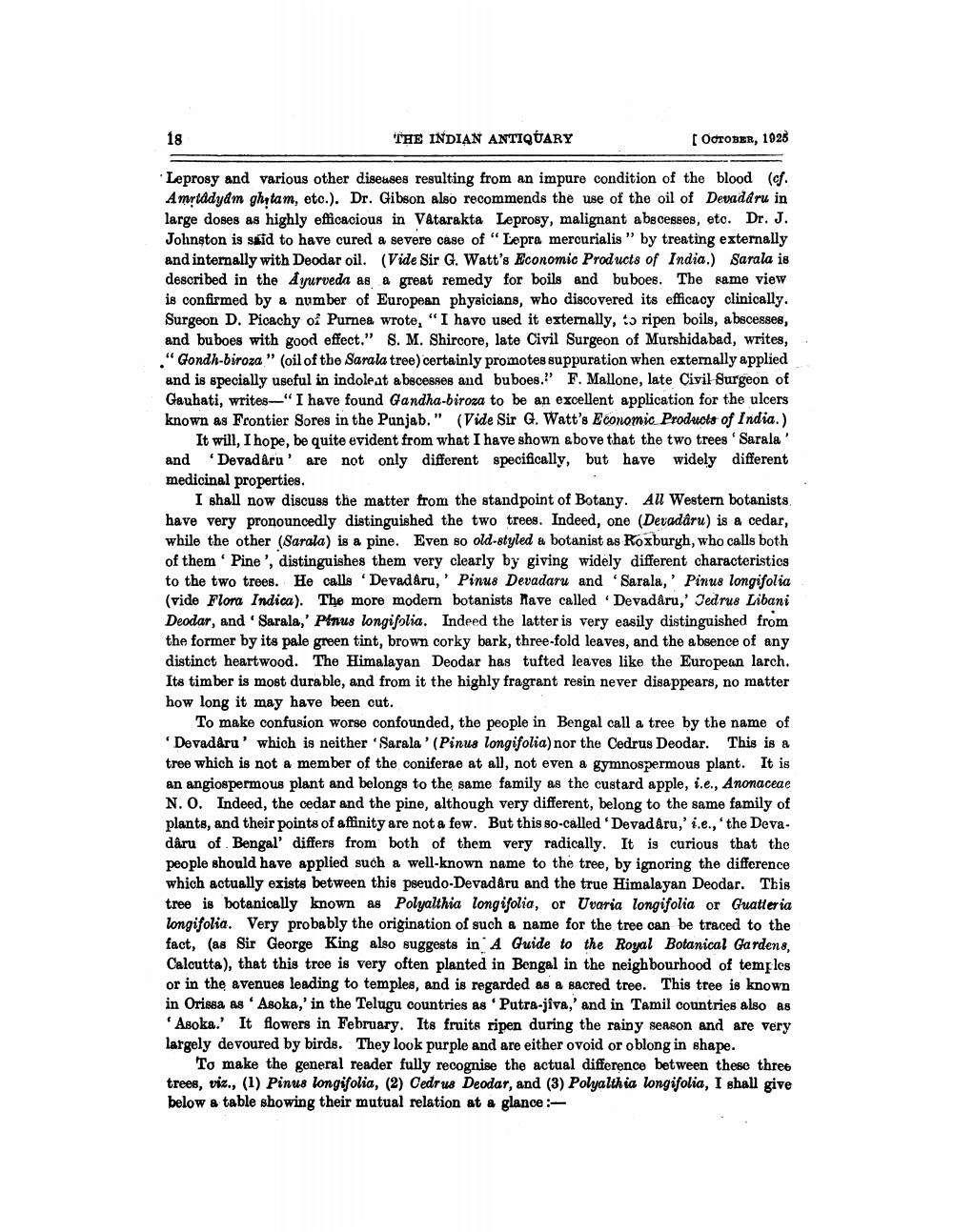________________
18
THE INDIAN ANTIQUARY
[OCTOBER, 1925
Leprosy and various other diseases resulting from an impure condition of the blood (cf. Amriádydm ghatam, etc.). Dr. Gibson also recommends the use of the oil of Devadaru in large doses as highly efficacious in Vatarakta Leprosy, malignant abscesses, eto. Dr. J. Johnston is said to have cured a severe case of "Lepra mercurialis" by treating externally and internally with Deodar oil. (Vide Sir G. Watt's Economic Products of India.) Sarala is described in the Ayurveda as a great remedy for boils and buboes. The same view is confirmed by a number of European physicians, who discovered its efficacy clinically. Surgeon D. Picachy of Purnea wrote, “I have used it externally, to ripen boils, abscesses, and buboes with good effect." S. M. Shircore, late Civil Surgeon of Murshidabad, writes, "Gondh-biroza" (oil of the Sarala tree) certainly promotes suppuration when externally applied and is specially useful in indoleat abscesses and buboes." F. Mallone, late Civil Surgeon of Gauhati, writes--"I have found Gandha-biroza to be an excellent application for the ulcers known as Frontier Sores in the Punjab." (Vide Sir G. Watt's Economic Products of India.)
It will, I hope, be quite evident from what I have shown above that the two trees 'Sarala' and 'Devadaru' are not only different specifically, but have widely different medicinal properties.
I shall now discuss the matter from the standpoint of Botany. AU Western botanists, have very pronouncedly distinguished the two trees. Indeed, one (Devadaru) is a cedar, while the other (Sarala) is a pine. Even so old-styled a botanist as Roxburgh, who calls both of them Pine', distinguishes them very clearly by giving widely different characteristics to the two trees. He calls Devadaru,' Pinus Devadaru and Sarala,' Pinus longifolia (vide Flora Indica). The more modern botanists have called Devadâru,' Jedrus Libani Deodar, and Sarala,' Pinus longifolia. Indeed the latter is very easily distinguished from the former by its pale green tint, brown corky bark, three-fold leaves, and the absence of any distinct heartwood. The Himalayan Deodar has tufted leaves like the European larch. Its timber is most durable, and from it the highly fragrant resin never disappears, no matter how long it may have been cut.
To make confusion worse confounded, the people in Bengal call a tree by the name of Devadaru' which is neither Sarala' (Pinus longifolia) nor the Cedrus Deodar. This is a tree which is not a member of the coniferae at all, not even a gymnospermous plant. It is an angiospermous plant and belongs to the same family as the custard apple, i.e., Anonaceae N. O. Indeed, the cedar and the pine, although very different, belong to the same family of plants, and their points of affinity are not a few. But this so-called 'Devad aru,' i.e., 'the Deva. dâru of Bengal' differs from both of them very radically. It is curious that the people should have applied such a well-known name to the tree, by ignoring the difference which actually exists between this pseudo-Devadaru and the true Himalayan Deodar. This tree is botanically known as Polyalthia longifolia, or Uvaria longifolia or Guatteria longifolia. Very probably the origination of such a name for the tree can be traced to the fact, (as Sir George King also suggests in A Guide to the Royal Botanical Gardens, Caloutta), that this troe is very often planted in Bengal in the neighbourhood of temples or in the avenues leading to temples, and is regarded as a sacred tree. This tree is known in Orissa as Asoka,' in the Telugu countries as 'Putra-jiva,' and in Tamil countries also as
Asoka.' It flowers in February. Its fruits ripen during the rainy season and are very largely devoured by birds. They look purple and are either ovoid or oblong in shape.
To make the general reader fully recognise the actual difference between these three trees, viz., (1) Pinus longifolia, (2) Cedrus Deodar, and (3) Polyalthia longifolia, I shall give below a table showing their mutual relation at a glance :




